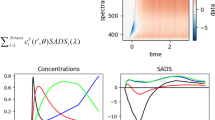Abstract.
Recent achievements in the theoretical description of exciton transfer in photosynthetic antennae are reviewed. Emphasis is put on the role of the protein matrix in the process of excitation energy dissipation. The computations are based on the standard Frenkel-exciton model including some necessary extensions. To carry out the simulations of experimental spectra the density-matrix theory is utilized. A numerical Monte Carlo treatment is applied to account for structural and energetic disorder. The approach is used to interpret various measurements on photosynthetic antenna systems. In particular, it is demonstrated how the exciton spectrum can be used as a probe for the protein spectral density.
Similar content being viewed by others
Author information
Authors and Affiliations
Additional information
Received: 8 November 1999 / Published online: 30 June 2000
Rights and permissions
About this article
Cite this article
May, V., Renger, T. Theory of sub-picosecond exciton motion in photosynthetic antenna systems . Appl Phys B 71, 451–456 (2000). https://doi.org/10.1007/s003400000349
Published:
Issue Date:
DOI: https://doi.org/10.1007/s003400000349




